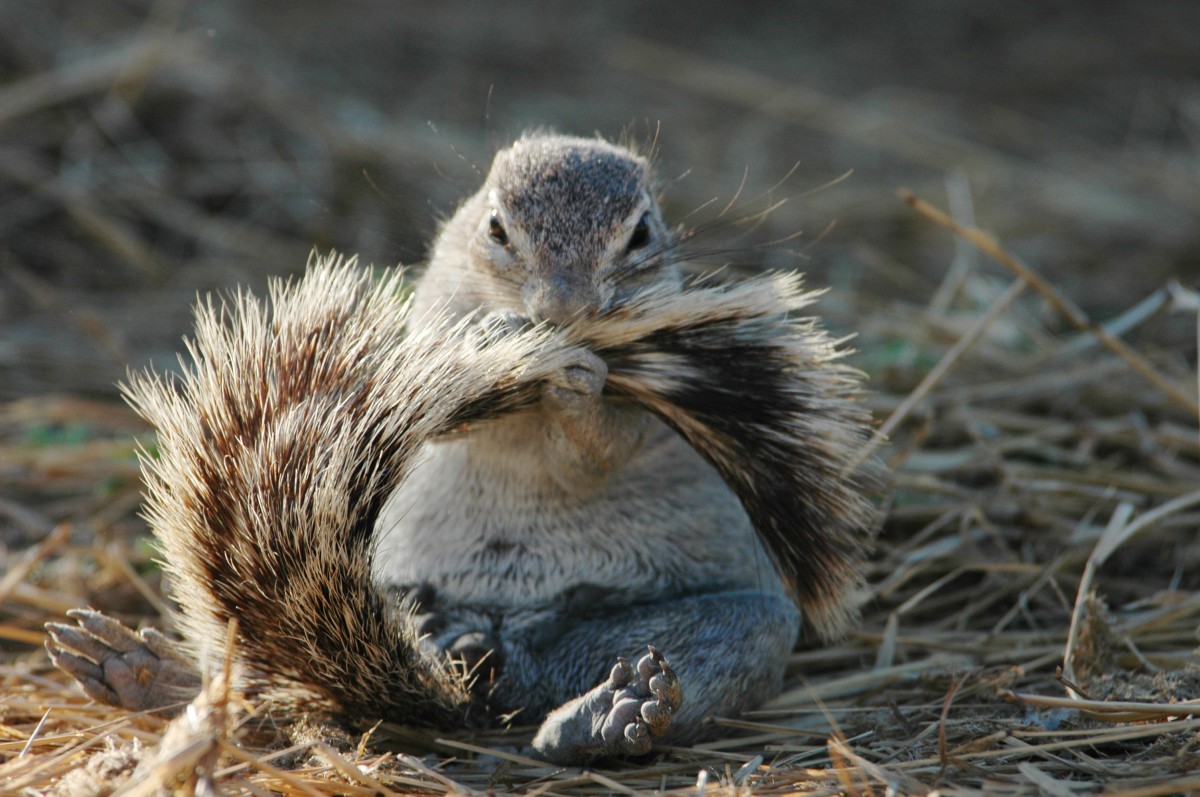
A Cape ground squirrel grooming in Namibia // Photo: Jane Waterman
Squirrel sperm and feet tell a different climate change story
Perhaps it’s time to replace the canary in a coal mine metaphor with a squirrel in the ground. Because two University of Manitoba studies found that climate change is altering ground squirrels’ sperm and feet, and this warns of big consequences potentially coming to endangered ecosystems.
These subtle squirrel changes concern UM researchers Jane Waterman and Miya Warrington, who tuned into them only recently and published their latest findings in the latest Journal of Mammalogy.
It began last year when they found that some male Richardson’s ground squirrels, a species found throughout the Canadian prairies, emerged from hibernation during a particularly warm winter with non-motile sperm. This non-lethal effect of climate change fortunately did not result in fewer young that year, although other negative consequences of males “shooting blanks” may emerge in other species or situations.
Intrigued by this finding, they then looked at what non-lethal affects climate change was having on African ground squirrels in the grasslands of South Africa.
Waterman, head of the Behavioural, Ecological & Evolutionary Research Lab at UM, has run a 20-year research project on a population of Cape ground squirrels at a nature reserve in South Africa, and so has a trove of invaluable data that she and post-doctoral fellow Warrington could rely on. They began looking at how these squirrels were responding to increased ambient temperatures and were astounded to find that as maximum temperatures at the nature reserve have risen by more than 2°C, the relative size of ground squirrel feet have increased, while their bodies have become smaller. It seems that ground squirrels in South Africa are responding to the warming climate by “shape-shifting.”
“These proportionally bigger feet may help the ground squirrel cool off by allowing them to shed more heat even faster than those squirrel with smaller feet. Likewise, smaller bodies are predicted to help animals shed heat at a faster rate than larger-bodied animals,” says Warrington, the lead author. “This result suggests that ground squirrel bodies may be changing in response to the greater heat stress that these animals are experiencing in recent years.”
Animals responding to rising temperatures is not entirely unexpected. However, changes in animal shapes in response to climate change may have farther reaching consequences beyond external aesthetics.
“If the body is changing, what else is changing,” muses Warrington. “We’d also like to look at internal changes, things like the effects of stress and hormones, as well as the effect on behaviours. Cape ground squirrels are very social species, and changes to their bodies and behaviours can affect how they operate as a social species, which then may affect their survival and reproduction.”
Waterman notes that “Cape ground squirrels are ecosystem engineers. They change the vegetation around their burrow clusters and increase grassland biodiversity, so changes in their body size and behaviour can have consequences to the biodiversity of temperate grasslands, which are one of the most endangered ecosystems on the planet.”
When it comes to the effects of climate change, images of mass animal death from wildfires, drought and floods abound. Yet, this research team shows that the effects of climate change need not be drastic or fatal to have consequences. And these subtle, non-fatal effects of climate change, may, in the long-run, affect the health and resiliency of wildlife and their ecosystems.
“Our study, and the studies of many others, are showing us that nature, in some cases, can respond quickly to rapid environmental changes. Humans need to be mindful of all effects of climate change, even ‘small’ ones so we can respond with deliberate, swift action as needed,” Warrington says.
When a canary stops singing, recognize the danger. So too when ground squirrels shoot blanks and develop bigger feet.
Research funding came from the National Science Foundation, Natural Sciences and Engineering Research Council, Canadian Foundation for Innovation, Manitoba Research and Innovation Grant, University of Manitoba Faculty of Science
Research at the University of Manitoba is partially supported by funding from the Government of Canada Research Support Fund.






